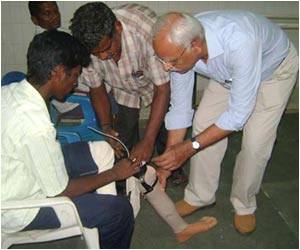An inadvertent contribution has been made by women in stilettos and ostriches towards scientific progress by showing researchers to design a prosthetic leg better adapted for walking, states study.

"It now appears that making prosthetic feet -- for walking at least -- copying human feet too closely can be a mistake," study author Jim Usherwood of the Royal Veterinary College in London told AFP.
"If you want to make a good prosthetic foot but don't care what it looks like, you should put the motor -- in this case the ankle -- as far up the leg as possible."
Higher up, the ankle "can provide the power without making the feet heavy and hard to swing backwards and forwards," he added.
Usherwood and his team found that the human way of walking -- crashing on the heel, vaulting over the stationary leg and then pushing off with the toes, was the most economic given the shape of our foot -- a design which in some ways "does not make sense".
This walking method was "very unusual" outside the hominoidea family of apes and humans. Other bipedal animals like ostriches have no ground-striking heels, but rather extensive tendons that act as springs.
Advertisement
The scientists observed that women in heels had to wiggle their bottoms to allow them to keep walking in the "crash, vault, push" pattern.
Advertisement
"This is a benefit as muscles use energy when opposing force. But motors don't -- so prosthetics and robotics should not copy human feet."
The study concluded that "less human-like feet would allow the benefits of more natural human walking, in which steps are taken relatively quickly allowing relatively short steps and high walking speeds".
Double amputee Pistorius, dubbed the Blade Runner, has been at the centre of controversy with critics claiming his carbon fibre prosthetic legs gave him an advantage over able-bodied athletes in mixed competitions.
Source-AFP









